On paper, the MiG-29K looks promising. However, some recent accidents have their future in doubt at least in India: The aircraft carrier serves a simple function – as the name suggests – to transport aircraft. Yet, the aircraft carrier, like overseas bases, is fundamental to power projection. No great power, or even regional power, is without an aircraft carrier. In fact, a country’s aircraft carriers are a somewhat reliable metric of a country’s wealth – and ambition. America has 11 active-duty aircraft carriers, for example, each capable of carrying over 100 F/A-18 Hornets. Russia, on the other hand, has only one aircraft carrier, the beleaguered Admiral Kuznetsov. The Kuznetsov, perhaps best known for its noxious emissions, is capable of carrying just 24 jets at once – six of which are typically the MiG-29K, an all-weather carrier-based multi-role fighter.
The MiG-29K is an outgrowth of the MiG-29M. The K-variant, designed to meet the punishing specifications of carrier operations, features a beefed-up undercarriage, reinforced tail section, catapult attachments, and arrestor hook. Additionally, the K-variant has a folding-wing (to save space aboard the Admiral Kuznetsov) and increased wing area (to generate more lift in aiding short take-offs).
On November 1, 1989, Kazakh test pilot (and later cosmonaut) Toktor Aubakirov made the MiG-29K’s maiden flight. Aubakirov put the K-variant through its paces, first landing on the Kuznetsov, and later that same day, successfully performing a carrier-based take-off. Using a “ski-jump” runway, the K-variant can perform very short take-offs.
For power, the MiG-29K relies on two widely spaced, specially modified RD-33MKs. The MK-version, found on the MiG-29, produces 7% more power than the standard RD-33. For shipborne operations, the RD-33MKs generate nearly 21,000 pounds of thrust, per engine, on take-off. The MK-engine was also designed to reduce infrared signature, making the MiG harder to detect. With a top speed over Mach 2, the MiG-29K combat radius is 810 miles, thanks to three underwing external drop tanks. The jet can cruise at Mach 1.21 and operate within a service ceiling of 57,400 feet. The MiG can climb at an impressive 65,000 feet per minute and pull eight or more G’s.
The K-variant is equipped with a GSg-30-1 30 mm cannon, found in the port wing. The jet can also carry laser-guided and electro-optical bombs, plus air-to-surface missiles. While the MiG-29K is not a stealth aircraft, the jet features low-observable technology, including radar-absorbent materials. Allegedly, the K-variant’s radar signature is four to five times less than the standard MiG-29. Onboard the MiG-29K is a capable Zhuk-ME radar system. The Zhuk radar is capable of terrain mapping, improved signal processing, and a detection range of up to 75 miles. A sophisticated, 500 pound radar, the Zhuk can track up to ten targets simultaneously; four targets can be engaged simultaneously.
Russia isn’t the only MiG-29K operator. India also has a batch. In 2004, India ordered a dozen single-seat K-variants (and four two-seat KUB-variants), for the purpose of populating India’s growing aircraft carrier fleet; India purchased Russia’s Admiral Gorshkov aircraft carrier (and renamed it the INS Vikramaditya). India also has their own, homegrown aircraft carrier, the INS Vikrant.
In the last few years, the two-seat KUB-variant’s reputation has been mired in a series of accidents. Two Indian MiGs crashed in 2020 (and another in 2019) leaving the Indians concerned with the quality of the Russian aircraft. It even seems now India is getting set to potentially dump the MiG-29K in the near future as it looks into possible replacements.
Harrison Kass is a Senior Defense Editor at 19FortyFive. An attorney, pilot, guitarist, and minor pro hockey player, he joined the US Air Force as a Pilot Trainee but was medically discharged. Harrison has degrees from Lake Forest College, the University of Oregon, and New York University. He lives in Oregon and regularly listens to Dokken.

